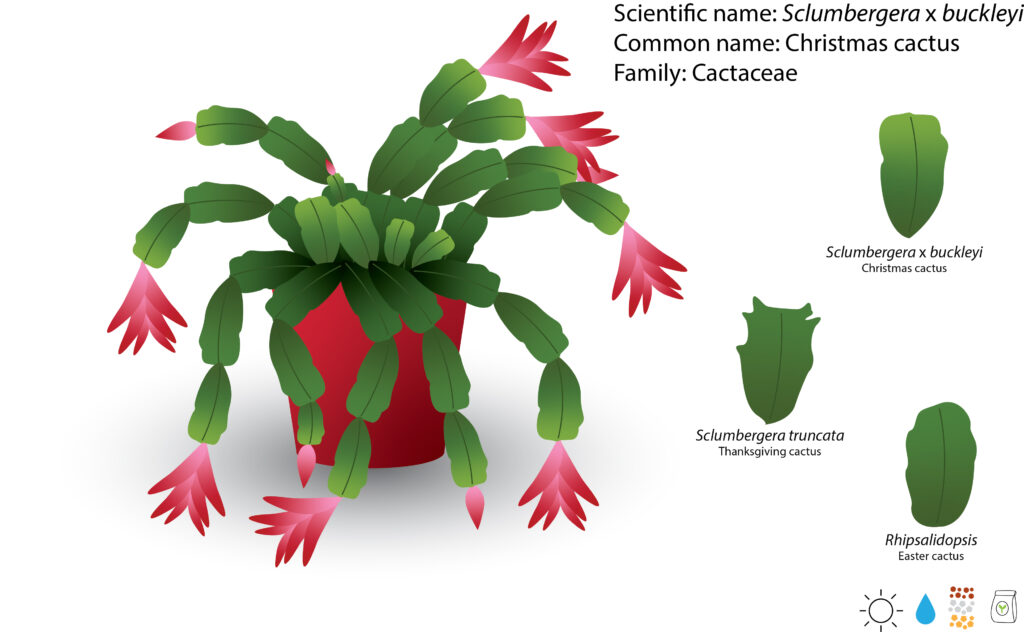Christmas cacti are familiar flower shop pot plants. Cacti of this genus, Schlumbergera, are some of the most widely cultivated and enjoyed cacti. It is named to honor Fréderic Schlumberger, an avid French cultivator of cacti and other succulents. It is a tough plant that can grow over a year and it is suitable for Thanksgiving and Easter. This genus consists of six species of bushy cacti that are originated from southeastern Brazil. They gave flattened, spinless, and rather weeping branches with intended notches at the margins. The scientific name of Christmas cacti was Zygocactus, which was updated to Schlumbergera about thirty years ago. Currently, most plants sold are hybrids. The bright flowers appear at the stem tips and are attractive, asymmetrical shape. In addition, they come in shades from palest pink to orange, magenta, scarlet, and white. They are often grown in a hanging basket but do not cascade vigorously enough to cover the basket, looking their best in tall pots.
Schlumbergera is distinctive cacti that show two different forms in term of growth. The species that were previously classified in Epiphyllanthus taxonomically like S. microsphaerica and S. opuntiodes have Opuntia-like stem segments that have cylindrical or compressed shapes with the areoles distributed more or less evenly over the entire surface. On the other hand, those species found in Schlumbergera or Zygocactus such as S. kautskyi, S. orssichiana, S, russelliana, S. truncate have flattened segments on young stems with areoles that are restricted to the margin and tips. Similar to other succulents, species of Schlumbergera prefer mild, frost-free climates. However, they make the excellent indoor plant in a cooler area where there is white Christmas provided strong sunlight or lighting sources are provided. It can be potted in rich and well-drained soil at semi-shade. They have spectacular flowers in which the flowers are pollinated by birds. Once they had set their flower buds, changing location would result in shock that caused them to drop their buds. It is easily propagated from stem cuttings like other succulents in spring or early summer. Besides, germination of the seedlings is an alternative for Christmas cactus propagation.
One of the most popular hybrids of the Christmas cacti is Schlumbergera x buckleyi. This epiphytic hybrid is a readily branching cactus that produces upright stems that arch in maturity. These stems are made of flat, rectangular, or cylindrical links covered with bristly areoles that are often margined with notched edges. This hybrid is prominent and has cylindrical flowers bloom from the tops of the stems in fall and winter. Furthermore, there is another interesting cultivar, which is Schlumbergera ‘Santa Cruz’ that was bred in California and introduced to other countries in 1989. A crab cactus, which scientifically called Zygocactus truncactus or Schlumbergera truncata is originated from southeastern Brazil. Furthermore, S. truncata is commonly known as the thanksgiving cactus, which acts as a great decorative plant for the festival and it is used to display in thanksgiving. It bears deep pink, red, orange, or white flowers that have three inches long whereby the flowering period starts from late fall to winter. This species can reach twelve inches in height. The bright green stems have prominent and tooth-like marginal notches.

Further reading:
Anderson. E., F. (2001). The cactus family. Timber Press. Portland, Oregon.
Rätsch. C. & Műller-Ebeling. C. (2009). Pagan Christmas – The plant, spirits, and rituals at the origins of Yuletide. Rochester, Vermont.